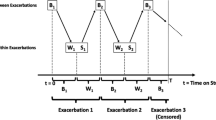Abstract
In the literature studying recurrent event data, a large amount of work has been focused on univariate recurrent event processes where the occurrence of each event is treated as a single point in time. There are many applications, however, in which univariate recurrent events are insufficient to characterize the feature of the process because patients experience nontrivial durations associated with each event. This results in an alternating event process where the disease status of a patient alternates between exacerbations and remissions. In this paper, we consider the dynamics of a chronic disease and its associated exacerbation-remission process over two time scales: calendar time and time-since-onset. In particular, over calendar time, we explore population dynamics and the relationship between incidence, prevalence and duration for such alternating event processes. We provide nonparametric estimation techniques for characteristic quantities of the process. In some settings, exacerbation processes are observed from an onset time until death; to account for the relationship between the survival and alternating event processes, nonparametric approaches are developed for estimating exacerbation process over lifetime. By understanding the population dynamics and within-process structure, the paper provide a new and general way to study alternating event processes.




Similar content being viewed by others
References
Andersen PK, Gill RD (1982) Cox’s regression model for counting processes: a large sample study. Ann Stat 10(4):1100–1120
Cook RJ, Lawless JF (2007) The statistical analysis of recurrent events. Springer, Berlin
Fleming TR, Harrington DP (1991) Counting processes and survival analysis, vol 8. Wiley, New York
Gogtay N, Vyas NS, Testa R, Wood SJ, Pantelis C (2011) Age of onset of schizophrenia: perspectives from structural neuroimaging studies. Schizophr Bull 37(3):504–513
Hu XJ, Lagakos SW (2007) Nonparametric estimation of the mean function of a stochastic process with missing observations. Lifetime Data Anal 13(1):51–73
Hu XJ, Lorenzi M, Spinelli JJ, Ying SC, McBride ML (2011) Analysis of recurrent events with non-negligible event duration, with application to assessing hospital utilization. Lifetime Data Anal 17(2):215–233
Huang CY, Wang MC (2004) Joint modeling event and estimation for recurrent processes and failure time data. J Am Stat Assoc 99(468):1153–1165
Lin DY, Wei LJ, Yang I, Ying Z (2000) Semiparametric regression for the mean and rate functions of recurrent events. J R Stat Soc B 62(4):711–730
Müller H-G (1991) Smooth optimum kernel estimators near endpoints. Biometrika 78(3):521–530
Munk-Jorgensen P, Mortensen PB (1992) Incidence and other aspects of the epidemiology of schizophrenia in denmark, 1971–87. Br J Psychiatry 161(4):489
Pena EA, Strawderman RL, Hollander M (2001) Nonparametric estimation with recurrent event data. J Am Stat Assoc 96(456):1299–1315
Prentice RL, Williams BJ, Peterson AV (1981) On the regression analysis of multivariate failure time data. Biometrika 68(2):373
Ross SM (1983) Stochastic processes, vol 23. Wiley, New York
Schaubel DE, Cai J (2005) Semiparametric methods for clustered recurrent event data. Lifetime Data Anal 11(3):405–425
Wang MC (2005) Length bias. In: Armitage P, Colton T (eds) Encyclopedia of biostatistics. Wiley, New York, pp 2756–9
Wang MC, Chang SH (1999) Nonparametric estimation of a recurrent survival function. J Am Stat Assoc 94(445):146–153
Wang MC, Qin J, Chiang CT (2001) Analyzing recurrent event data with informative censoring. J Am Stat Assoc 96:1057–1065
Yan J, Fine JP (2008) Analysis of episodic data with application to recurrent pulmonary exacerbations in cystic fibrosis patients. J Am Stat Assoc 103(482):498–510
Ye Y, Kalbfleisch JD, Schaubel DE (2007) Semiparametric analysis of correlated recurrent and terminal events. Biometrics 63(1):78–87
Author information
Authors and Affiliations
Corresponding author
Appendix
Appendix
The follow assumptions are the regularity conditions:
-
(C1)
The constant \(\tau \) satisfies \(P(X\ge \tau )>0\).
-
(C2)
We assume that the number of switches between exacerbation and remission is bounded.
-
(C3)
The function \(\phi _c(s | y)\) has second order derivative with respect to y, and the density f(y) has second order derivative \(f^{(2)}(y)\).
1.1 Proof for Theorem 4.1
We note that \(\{D(s):s\in [0,\tau ]\}\) and \(\{I(X\ge s):s\in [0,\tau ]\}\) are bounded and of bounded variation, and thus are Donsker. For \(s\in [0,\tau ]\), \(n^{-1/2}\sum _{i=1}^{n}\{ D_i(s)I(X_i\ge s) - P(D(s) = 1, X\ge s)\}\) and \(n^{-1/2}\sum _{i=1}^{n}\{ I(X_i\ge s) - P(X\ge s)\}\) converge to zero-mean Gaussian processes. By applying functional Delta method, we have \(\sqrt{n}\{\hat{\phi }(s) - \phi (s) \}\) converges weakly to a zero-mean Gaussian process and
Thus \(\sqrt{n}\{\hat{\phi }(s) - \phi (s) \}\) converges weakly to a zero-mean Gaussian process with covariance function \(E\{a(s_1)a(s_2)\}\) for \(s_1,s_2\in [0,\tau ]\).
1.2 Proof for Theorem 4.2
We first define
We further define
Note that \(E\{\tilde{\mu }_{i}(s,y)\} = \mu (s,y)\) and \(E\{\tilde{\lambda }_{i}(y)\} = \lambda (y)\). Let \(f^{(2)}\) be the second order derivative of f. With straightforward algebra, we have
For \(0<s<y<\tau \), we have
By applying Equations ( 9)–(13), we have
and \(h\mathrm{Var}\left\{ {f^{-1}(y)}\tilde{\mu }_{i}(s,t) - \phi _c(s | y){f^{-1}(y)} \tilde{\lambda }_{i}(y) \right\} \) is
Then the result of \(\hat{\phi }_c(s;y)\) when \(0\le s<y\le \tau \) is proved by applying central limit theorem.
1.3 Proof for asymptotic distribution of W
We assume (C1) and (C2) hold. Under the null hypothesis \(\mathcal{H}_0\): \(\phi _1(s)=\phi _2(s)\), \(0\le s\le \tau \), we have
For the kth group, define \(b_{ki}= \int _0^\tau w(s) a_{ki} (s) ds \), where
Then by applying arguments similar to the proof of Theorem 4.1, we have
By applying the central limit theorem, we see that the test statistic \((n_1n_2/N)^{1/2}W\) converges in distribution to a normal distribution with zero mean and variance \(p_2E( b_{1i}^2)+p_1E( b_{2i}^2)\).
Rights and permissions
About this article
Cite this article
Shinohara, R.T., Sun, Y. & Wang, MC. Alternating event processes during lifetimes: population dynamics and statistical inference. Lifetime Data Anal 24, 110–125 (2018). https://doi.org/10.1007/s10985-017-9404-5
Received:
Accepted:
Published:
Issue Date:
DOI: https://doi.org/10.1007/s10985-017-9404-5




